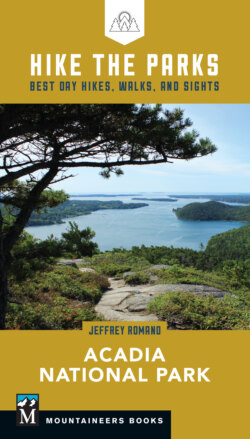Читать книгу Hike the Parks: Acadia National Park - Jeff Romano - Страница 19
На сайте Литреса книга снята с продажи.
CARPETS OF PLANTS AND FUNGI
ОглавлениеThe combination of Acadia’s mountains and its proximity to the ocean leads to a summer climate that is moister and cooler than that of flatter, nearby inland regions. Often shrouded in fog, especially early in the summer, the park is fertile ground for more than a thousand species of plants and fungi.
Wildflowers. On most hikes in the park, you will encounter many different species of wildflowers. In the forests, look for carpets of bunchberry and bluebead lily as well as many other less showy and less common species. Rhodora and sheep laurel add color and texture to the park’s rocky evolve slowly, human activities are accelerating many natural processes as the changing climate increases average temperatures, sea level rise, and storm intensities. summits and open areas at different times throughout the spring and summer. During the fall, the bright red leaves of highbush blueberry do the same, along with the purple petals of asters.
Rhodora adds splashes of bright color to Acadia in late spring.
Wetland Plants. Acadia’s freshwater wetlands provide fertile grounds, home to roughly eighty plants. Some of the most sensitive wetland species are found in the region’s bogs, where sphagnum moss, pitcher plants, and Labrador tea find ways to thrive. The park is also home to many intertidal marine plants and algae, including rockweed, that provide critical habitat for many wildlife species during low and high tides.
Ferns, Mosses, and Fungi. The park’s cool, wet climate sustains many species of ferns, mosses, and fungi, which thrive in shady, wet soils. The ferns, surfacing in the spring, add greenery well into the fall. Mushrooms and other fungi are most abundant in the late summer and early autumn. Picking mushrooms is prohibited in the park, but marveling at their many shapes and colors is not.
Grasses. By far the most common plants encountered in the park are “grasses.” Approximately one in four Acadia plants fall into this category, which includes grasses, sedges, and rushes. Atop the park’s mountain ridges many of these species are fragile. Be sure to stay on trails and rocky surfaces to avoid trampling these high-elevation plants.
Non-Native Species. In the four centuries following the arrival of European settlers to the region, Acadia’s plant composition has changed a great deal. Today, nearly 25 percent of all plant species in the park are non-native. Among the non-native plants, roughly thirty species significantly harm native plants and habitats. Acadia park management continues to find ways to minimize the impacts of these exotic plants.
